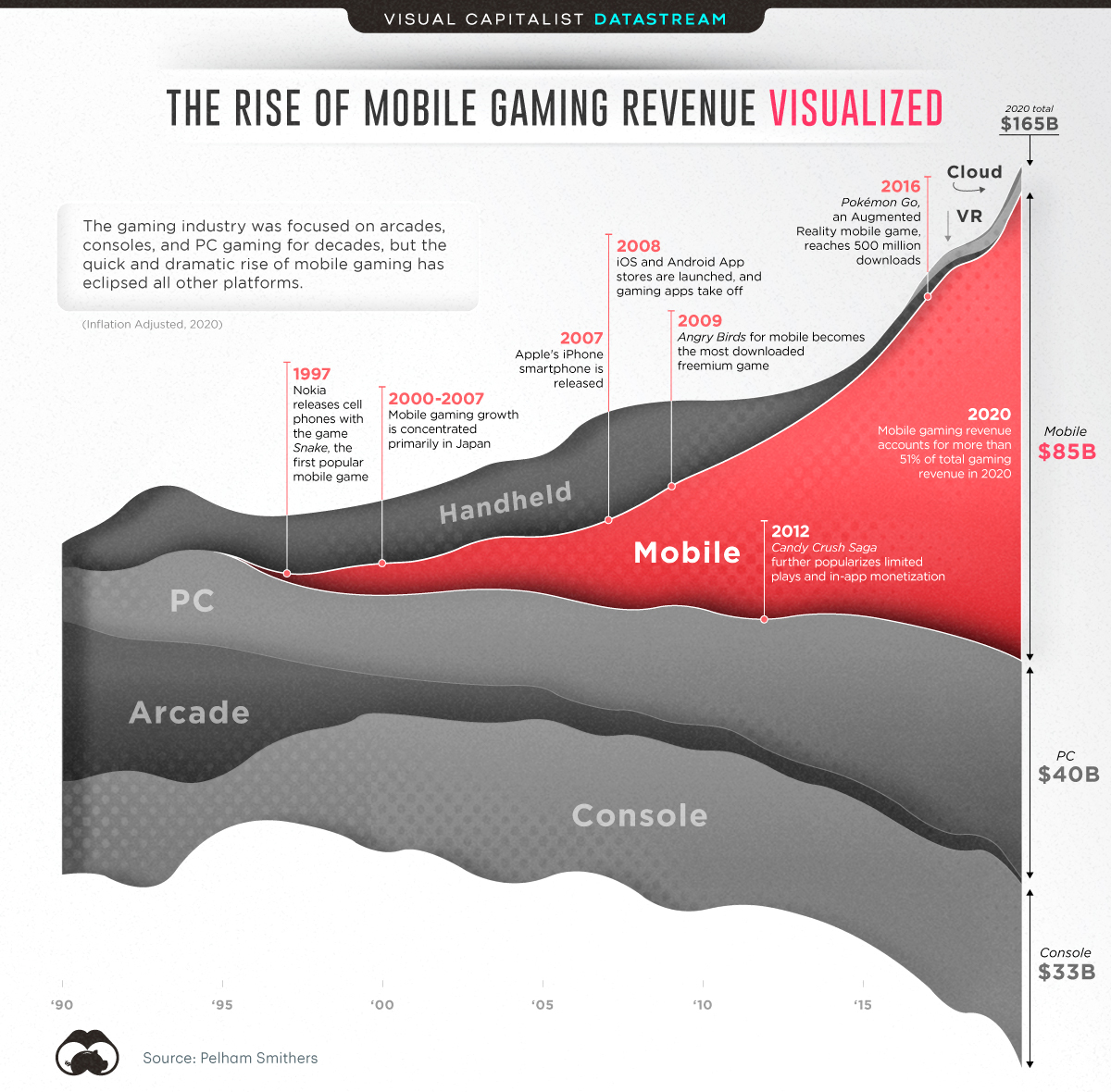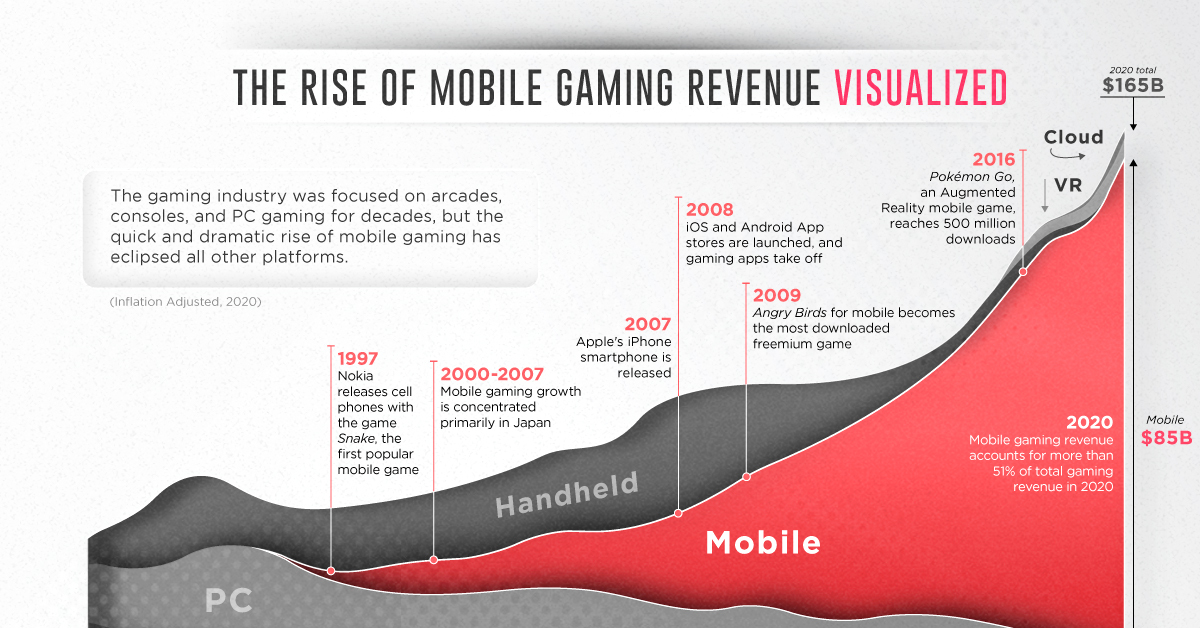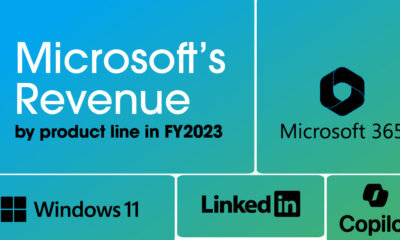Datastream
How Big is the Global Mobile Gaming Industry?

The Briefing
- Mobile gaming revenue for 2020 is estimated at $85 billion, more than half of the sector’s estimated $165 billion
- Despite the launch of high-profile consoles, most gaming companies are focusing on platform-agnostic subscription services that can penetrate mobile
The Mobile Gaming Takeover
While the gaming market spotlight is focused on new consoles and games this holiday season, the bigger focus for insiders continues to be the mobile sector.
Over the last 20 years, mobile gaming has gone from the industry’s entertaining afterthought to its largest source of revenue—in 2020, the sector is estimated to have generated around $85 billion.
In light of COVID-19 keeping many consumers at home, gaming companies like Electronic Arts and Activision Blizzard have reported higher year-over-year revenues and greater market penetration than ever before.
Companies Race to Capitalize on Mobile Gaming
The massive industry growth hasn’t gone unnoticed by companies outside of the gaming sector. In fact, it has emboldened many to make billion-dollar entries into the gaming market that failed to pan out in the early 2000s.
In the bid to capture the cloud-service sphere and become the “Netflix” of gaming, major services have been launched by Microsoft, Sony, Nokia, Amazon, and Google.
At the same time, publishers have been racing to consolidate gaming franchises on the path towards building massive recurring revenue streams.
| Date | Acquirer | Target and Sector | Deal Value (US$) |
|---|---|---|---|
| Apr. 2014 | Oculus - VR | $3.0 Billion | |
| Aug. 2014 | Amazon | Twitch - Streaming | $1.0 Billion |
| Nov. 2014 | Microsoft | Mojang - Games | $2.5 Billion |
| Feb. 2016 | Activision Blizzard | King - Games | $5.9 Billion |
| Jun. 2016 | Tencent | Supercell - Games | $8.6 Billion |
| Feb. 2020 | Embracer Group | Saber Interactive - Games | $0.5 Billion |
| Sep. 2020 | Microsoft | ZeniMax Media - Games | $7.5 Billion |
| Nov. 2020 | Take-Two Interactive | Codemasters - Games | $1.0 Billion |
With Sony and Microsoft’s new consoles fresh to market (and constantly sold out), next generation games hitting multiple platforms, and cloud services kicking off in earnest, traditional gaming sectors might finally start catching up to mobile.
But as the global proliferation of smartphones continues to grow, it will be an uphill challenge. With 2.7 billion estimated gamers already and growing, how much higher can the mobile gaming wave rise?
»Want a full breakdown of gaming revenue by sector? Read our full article 50 Years of Gaming History
Where does this data come from?
Source: Pelham Smithers.
Details: Research firm’s annual analysis of reported and estimated sector revenue.
Notes: This data was collected in September of 2020 and includes estimates for end-of-year.
Datastream
Can You Calculate Your Daily Carbon Footprint?
Discover how the average person’s carbon footprint impacts the environment and learn how carbon credits can offset your carbon footprint.

The Briefing
- A person’s carbon footprint is substantial, with activities such as food consumption creating as much as 4,500 g of CO₂ emissions daily.
- By purchasing carbon credits from Carbon Streaming Corporation, you can offset your own emissions and fund positive climate action.
Your Everyday Carbon Footprint
While many large businesses and countries have committed to net-zero goals, it is essential to acknowledge that your everyday activities also contribute to global emissions.
In this graphic, sponsored by Carbon Streaming Corporation, we will explore how the choices we make and the products we use have a profound impact on our carbon footprint.
Carbon Emissions by Activity
Here are some of the daily activities and products of the average person and their carbon footprint, according to Clever Carbon.
| Household Activities & Products | CO2 Emissions (g) |
|---|---|
| 💡 Standard Light Bulb (100 watts, four hours) | 172 g |
| 📱 Mobile Phone Use (195 minutes per day)* | 189 g |
| 👕 Washing Machine (0.63 kWh) | 275 g |
| 🔥 Electric Oven (1.56 kWh) | 675 g |
| ♨️ Tumble Dryer (2.5 kWh) | 1,000 g |
| 🧻 Toilet Roll (2 ply) | 1,300 g |
| 🚿 Hot Shower (10 mins) | 2,000 g |
| 🚙 Daily Commute (one hour, by car) | 3,360 g |
| 🍽️ Average Daily Food Consumption (three meals of 600 calories) | 4,500 g |
| *Phone use based on yearly use of 69kg per the source, Reboxed | |
Your choice of transportation plays a crucial role in determining your carbon footprint. For instance, a 15 km daily commute to work on public transport generates an average of 1,464 g of CO₂ emissions. Compared to 3,360 g—twice the volume for a journey the same length by car.
By opting for more sustainable modes of transport, such as cycling, walking, or public transportation, you can significantly reduce your carbon footprint.
Addressing Your Carbon Footprint
One way to compensate for your emissions is by purchasing high-quality carbon credits.
Carbon credits are used to help fund projects that avoid, reduce or remove CO₂ emissions. This includes nature-based solutions such as reforestation and improved forest management, or technology-based solutions such as the production of biochar and carbon capture and storage (CCS).
While carbon credits offer a potential solution for individuals to help reduce global emissions, public awareness remains a significant challenge. A BCG-Patch survey revealed that only 34% of U.S. consumers are familiar with carbon credits, and only 3% have purchased them in the past.
About Carbon Streaming
By financing the creation or expansion of carbon projects, Carbon Streaming Corporation secures the rights to future carbon credits generated by these sustainable projects. You can then purchase these carbon credits to help fund climate solutions around the world and compensate for your own emissions.
Ready to get involved?
>> Learn more about purchasing carbon credits at Carbon Streaming
-

 Mining1 week ago
Mining1 week agoGold vs. S&P 500: Which Has Grown More Over Five Years?
-

 Markets2 weeks ago
Markets2 weeks agoRanked: The Most Valuable Housing Markets in America
-

 Money2 weeks ago
Money2 weeks agoWhich States Have the Highest Minimum Wage in America?
-

 AI2 weeks ago
AI2 weeks agoRanked: Semiconductor Companies by Industry Revenue Share
-

 Markets2 weeks ago
Markets2 weeks agoRanked: The World’s Top Flight Routes, by Revenue
-

 Countries2 weeks ago
Countries2 weeks agoPopulation Projections: The World’s 6 Largest Countries in 2075
-

 Markets2 weeks ago
Markets2 weeks agoThe Top 10 States by Real GDP Growth in 2023
-

 Demographics2 weeks ago
Demographics2 weeks agoThe Smallest Gender Wage Gaps in OECD Countries

















